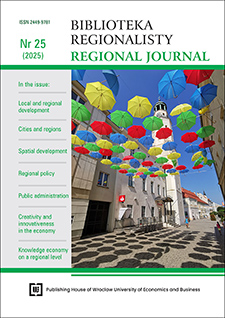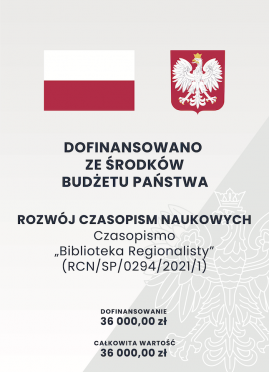Local government and national parks – how to break the deadlock in cooperation?
DOI:
https://doi.org/10.15611/br.2025.1.07Keywords:
national park, local government, governance, eco-compensationAbstract
Aim: The article analyses the stunted development of Poland's network of national parks, identifying key barriers to their expansion and proposing specific directions for corrective action, and highlights the unique role of national parks in environmental protection while pointing out that in Poland their share of the area is only 1.05%, which is significantly below the European Union average.
Methodology: The research included an analysis of the legal and economic aspects and a literature review, to identify the main problems limiting the development of national parks. Particular attention was paid to barriers stemming from resistance by local governments, the loss of forest tax revenues, and discrepancies in salaries between employees of national parks and State Forests.
Results: It was found that effective ways to overcome these challenges comprise introducing financial support mechanisms for local communities and fostering partnerships between the national parks and local governments. The findings suggest that changing the approach of the central administration and implementing a management model based on cooperation and dialogue could effectively revitalise the development process of national parks.
Implications and recommendations: The proposed solutions can be applied not only in Poland but also in other countries facing similar challenges. Implementing financial support mechanisms and a partnership-based model could enhance environmental protection and foster harmonious collaboration between national parks and local communities.
Originality/value: The strengths of this paper stems from its comprehensive, integrated analysis of the stagnation of national park development in Poland, which uniquely takes into account legal, economic, and socio-political factors. By reframing the creation of national parks as a process based on cooperation rather than antagonism, the article presents innovative theoretical and practical strategies that can be applied in Poland and countries facing similar challenges, balancing ecological goals with socio-economic realities.Downloads
References
Andersson, K., & Agrawal, A. (2011). Inequalities, Institutions, and Forest Commons. Global Environmental Change, 21(3), 866-875.
Ayivor, J. S., Nyametso, J. K., & Ayivor, S. (2020). Protected Area Governance and Its Influence on Local Perceptions, Attitudes and Collaboration. Land, 9, 310.
Babczuk, A., & Kachniarz, M. (2015). System finansowania parków narodowych w Polsce – stan obecny i kierunki pożądanych zmian. Związek Pracodawców Polskich Parków Narodowych.
Babczuk, A., & Kachniarz, M. (2015). Polskie parki narodowe – ujęcie instytucjonalne. Zeszyty Naukowe Uniwersytetu Szczecińskiego, 40, 203-214.
Bell, J., & Stockdale, A. (2015). Evolving National Park Models: The Emergence of An Economic Imperative and Its Effect on the Contested Nature of the ‘National’ Park Concept in Northern Ireland. Land Use Policy, 49, 213-226.
Borrini-Feyerabend, G., & Hill, R. (2015). Governance for The Conservation of Nature. In G. L. Worboys, M. Lockwood, A. Kothari, S. Feary, & I. Pulsford (Eds.), Protected Area Governance and Management (pp. 169-206). ANU Press.
Chapes, S., Spalding, M., & Jenkins, M. (2008). The World’s Protected Areas: Status, Values and Prospects in the 21st Century. University of California Press.
De Pourcq, K., Thomas, E., Arts, B., Vranckx, A., León-Sicard, T., & Damme, P. (2015). Conflict in Protected Areas: Who Says Co-Management Does Not Work? Plos One, 10(12), e0144943.
Dudley, N. (Ed.). (2008). Guidelines for Applying Protected Area Management Categories. IUCN.
Gaston, K. J., Jackson, S. F., Cantú-Salazar, L., & Cruz-Piñón, G. (2008). The Ecological Performance of Protected Areas. Annual Review of Ecology, Evolution, and Systematics, 39, 93-113.
Geldmann, J., Manica, A., Burgess Neil, D., Coad, L., & Balmford, A. (2019). A Global-Level Assessment of the Effectiveness of Protected Areas at Resisting Anthropogenic Pressures. Proceedings of the National Academy of Sciences of the United States of America, 116, 23209-23215.
GUS. (2021). Mały Rocznik Statystyczny Polski 2021. https://stat.gov.pl/download/gfx/portalinformacyjny/pl/defaultaktualnosci/5515/1/23/1/maly_rocznik_statystyczny_polski_2021_31.08.2021.pdf
IPBES. (2019). Global Assessment Report on Biodiversity and Ecosystem Services of the Intergovernmental Science-Policy Platform on Biodiversity and Ecosystem Services. E. S. Brondizio, J. Settele, S. Díaz, and H. T. Ngo (Eds). IPBES secretariat.
Klimkiewicz, M. (2021). Narodowy, a więc czyj? Dlaczego w Polsce nie powstają kolejne parki narodowe i jak to zmienić. Fundacja ClientEarth Prawnicy dla Ziemi. https://www.clientearth.pl/najnowsze-dzialania/materialy-do-pobrania/dlaczego-w-polsce-nie-powstaja-nowe-parki-narodowe-i-jak-to-zmienic/
Klub, P. (2022). A Proposal to Supplement the Network of Polish National Parks. Fundacja Dziedzictwo Przyrodnicze. https://przyrodnicze.org/projekty/25-nowych-parkow-narodowych-do-utworzenia-w-polsce/
Kulczyk-Dynowska, A., & Bal-Domańska, B. (2019). The National Parks in The Context of Tourist Function Development in Territorially Linked Municipalities in Poland. Sustainability, 11(7), 1996.
Kulczyk-Dynowska, A., & Przybyła, K. (2019). Protecting Nature in National Parks: The Spatial and Financial Contexts. Polish Journal of Environmental Studies, 28(4), 2673-2684.
Mika, M., Zawilińska, B., & Pawlusiński, R. (2016). Badanie ekonomicznego wpływu parków narodowych na lokalną gospodarkę. Podejście funkcjonalne w kontekście polskiej gospodarki w okresie transformacji. Human Geographies – Journal of Studies and Research in Human Geography, 10(1).
Ministerstwo Klimatu i Środowiska. (2024). Dodatkowe środki dla samorządów, w których występują obszary chronione. https://www.gov.pl/web/klimat/dodatkowe-srodki-dla-samorzadow-w-ktorych-wystepuja-obszary-chronione-projekt-ustawy-o-dochodach-jst
Mohedano Roldán, A., Duit, A., & Schultz, L. (2019). Does Stakeholder Participation Increase the Legitimacy of Nature Reserves in Local Communities? Evidence from 92 Biosphere Reserves in 36 Countries. Journal of Environmental Policy and Planning, 21, 188-203.
Moucheng, L., Lun, Y., Qingwen, M., & Weiguo, S. (2020). Theoretical Framework for Eco-Compensation to National Parks in China. Global Ecology and Conservation, 24, e01296.
Stoll-Kleemann, S. (2001). Opposition to the designation of protected areas in Germany. Journal of Environmental Planning and Management, 44, 109-128.
Sześciło, D. (2011). Regulacja tworzenia i powiększania parków narodowych w Polsce. Propozycja ClientEarth Poland na rzecz modelu partycypacyjnego. ClientEarth. https://otop.org.pl/uploads/media/national_parks_report-_final_pl_format.pdf
Sześciło, D. (2014). O (nie)racjonalnym ustawodawcy na przykładzie regulacji tworzenia i zmiany granic parków narodowych. Przegląd Prawa Ochrony Środowiska, 4, 113-130.
Therville, C., Casella-Colombeau, L., Mathevet, R., & Bioret, F. (2016). Beyond Segregative or Integrative Models for Protected Areas: A Case Study of French Nature Reserves. Environmental Conservation, 43, 284-293.
Ustawa z dnia 30 października 2002 r. o podatku leśnym (Dz. U. 2002. 200. 1682) [The Polish Forest Tax Act of October 30 2002]
Ustawa z dnia 27 sierpnia 2009 r. o finansach publicznych (Dz. U. z 2013, 888) [The Polish Public Financial Act of August 27 2009]
Ustawa z 1 października 2024 r. o dochodach jednostek samorządu terytorialnego (Dz. U. 2024, poz. 1572)
Walas, B., Nocoń, M., Pasierbek, T., & Sobczuk, J. (Eds.). (2019). Parki narodowe i otoczenie społeczno-gospodarcze. Skazani na dialog. Wyższa Szkoła Turystyki i Ekologii.
Wydra, Z. (Ed.). (2021). Polskie Parki Narodowe: dlaczego w Polsce od 20 lat nie powstał park narodowy i jak to zmienić? ClientEarth: Prawnicy dla Ziemi. https://ruj.uj.edu.pl/xmlui/handle/item/288001
Downloads
Published
Issue
Section
License
Copyright (c) 2025 Marian Kachniarz

This work is licensed under a Creative Commons Attribution-ShareAlike 4.0 International License.
Accepted 2025-02-28
Published 2025-06-27







